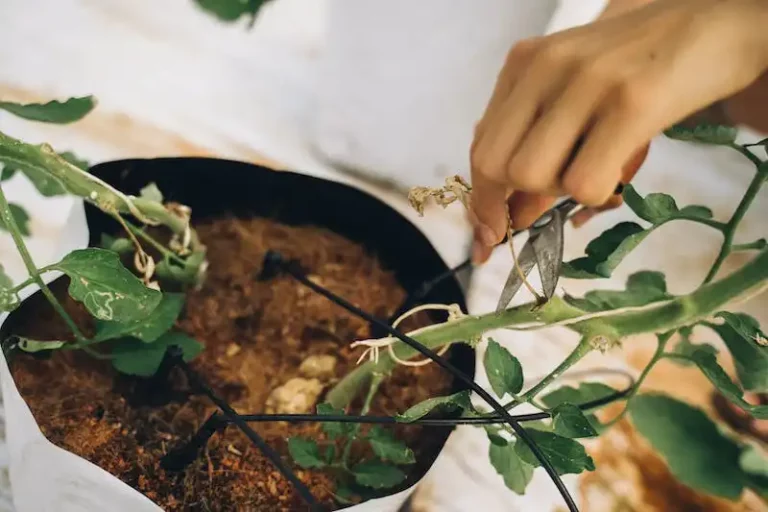Lemon thyme (Thymus citriodorus) is a popular herb known for its citrus-scented foliage and perfect addition to any garden. It is a variety of thyme that is commonly planted in gardens and is famous for its lemony fragrance. Lemon thyme can be grown outdoors in well-drained soil and is also suitable for indoor cultivation. If you’re a heavy gardener or just starting out, lemon thyme is a great herb to grow and care for.
One important aspect to consider when growing lemon thyme is the temperature and humidity. It prefers a moderate temperature range of 70°F to 85°F (21°C to 29°C) and can tolerate some frost. Lemon thyme requires a high humidity level, so make sure to water it regularly and provide proper air circulation. To give your lemon thyme a kick-start, sow the seeds indoors 6 to 8 weeks before the last frost date. Then, once the threat of frost is over, you can transplant the seedlings outdoors or keep them in containers.
Lemon thyme requires well-drained soil and should be watered regularly but not excessively. Make sure to water the plant at the base to prevent wetting the foliage, as this can lead to diseases. When it comes to fertilizing, lemon thyme doesn’t require much. A light application of a balanced organic fertilizer once or twice a year should be sufficient. If you’re growing lemon thyme in pots, use a well-draining potting mix and fertilize with a liquid fertilizer diluted to half strength every two weeks during the growing season.
Harvesting lemon thyme is easy. Simply snip off sprigs or whole stems as needed throughout the growing season. Harvesting the stems will encourage the plant to grow bushier and produce more foliage. You can use the fresh lemon thyme immediately or dry it for later use by hanging the stems in a dry, well-ventilated area. To store dried lemon thyme, strip the leaves from the stems and keep them in an airtight container in a cool, dark place.
If you’re new to growing and caring for lemon thyme or have questions about specific issues, don’t hesitate to ask a gardening expert. There are several ways to get information and guidance, such as visiting a local botanical garden, joining online gardening forums, or reaching out to a retail nursery. There are also mail-order suppliers who specialize in herb plants and can offer advice on growing and caring for lemon thyme.
In addition to its culinary uses, lemon thyme can also be used as a natural remedy. It is believed to have antibacterial and antifungal properties, and its essential oil is frequently used in herbal medicine. Lemon thyme essential oil can be extracted using distillation methods or purchased from retail stores. The oil is commonly used for its floral and citrusy aroma in perfumes, soaps, and candles.
In conclusion, growing and caring for lemon thyme can be a rewarding experience for any gardener. This versatile herb is easy to grow and adds a citrusy flavor and aroma to a variety of dishes. Whether you plant it in your garden or keep it indoors, lemon thyme will thrive with proper care and attention. So kickstart your gardening journey with lemon thyme and enjoy its many benefits for years to come!
Lemon Thyme Tiny Leaves With A Citrusy Kick
Lemon thyme is a delightful herb that adds a spruce of lemon-scented flavor to any dish. It is a variety of thyme that is native to the Mediterranean region, particularly in the mountainous areas. With its tiny leaves and refreshing citrusy aroma, lemon thyme has become a famous member of the thymus family.
When caring for lemon thyme, it is important to provide it with the right growing conditions. Lemon thyme thrives best in well-draining soil that is slightly alkaline. Throughout the growing season, it should be watered consistently to keep the soil moist but not waterlogged. Lemon thyme requires full sun exposure to flourish and develop its intense aroma and flavor.
One of the great things about lemon thyme is that it is relatively low maintenance. It doesn’t typically suffer from many diseases or pests. However, if any problems arise, a quick visit to the local nursery or doing some research online can provide valuable information on how to troubleshoot and solve the issue.
In terms of harvesting lemon thyme, it is best to wait until the plant is at least 9 inches tall before doing so. The leaves can be harvested throughout the growing season and used fresh or dried for later use. To harvest, simply snip off the top clusters of leaves with a pair of clean scissors or pruning shears.
During the winter months, lemon thyme may require some additional care. In colder regions, it is recommended to provide winter protection by storing the plant indoors or covering it with a layer of mulch. As with most herbs, lemon thyme benefits from occasional pruning to maintain its shape and encourage new growth.
When it comes to fertilizing lemon thyme, a light application of a balanced organic fertilizer in the spring should suffice. Be careful not to over-fertilize, as this can lead to excessive leaf growth and a diminished flavor.
If you are looking to add lemon thyme to your garden, it is readily available at most retail nurseries or can be ordered online. It is a popular choice among both experienced and novice gardeners due to its ease of care and delightful fragrance. Whether you are using it as a culinary herb or simply for its decorative appeal, lemon thyme is sure to bring a touch of citursy goodness to your garden.
Quick Care Guide
Here is a quick guide to growing and caring for lemon thyme:
- Lemon thyme is a citrusy herb that is commonly grown throughout the Mediterranean. It is a member of the Thymus vulgaris botanical family.
- Lemon thyme is a perennial herb that can be grown in USDA hardiness zone 8 and higher. It can also be grown in pots and brought indoors during colder months.
- To grow lemon thyme, plant it in well-draining soil that is high in organic matter. It likes full sun but can tolerate some light shade.
- Water your lemon thyme regularly, keeping the soil slightly moist but not waterlogged. Be careful not to overwater, as the roots can rot.
- Fertilize your lemon thyme every few weeks with a balanced fertilizer. This will help promote healthy growth and fuller foliage.
- Lemon thyme is known for its tiny leaves and lemon-scented flowers that grow in open clusters. It is a great addition to herb gardens or as a border plant in flower beds.
- Harvest lemon thyme by trimming the stem tips, just above a leaf node. This will encourage new growth and help keep the plant bushy.
- If you have any questions or need more information about lemon thyme, many gardening websites and retail stores have updated care guides available. Alternatively, you can contact your local garden center or agricultural extension service for expert advice.
- Lemon thyme is relatively disease-resistant, but some common problems include root rot and fungal diseases. Proper care, like providing good air circulation and well-draining soil, can help prevent these issues.
- If you want to propagate lemon thyme, it can be done through stem cuttings or by sowing seeds. Both methods are relatively easy and can yield new plants within a few weeks to a few months.
- When storing lemon thyme, you can dry the leaves and store them in an airtight container. This will help preserve their flavor for several months.
By following these care guidelines, you can enjoy the beautiful and fragrant lemon thyme in your garden or kitchen for many years to come!
All About Lemon Thyme
Lemon thyme, also known as Thymus citriodorus, is a popular herb that is loved for its fresh and floral lemon scent. It is a versatile herb that can be used in both culinary and ornamental applications. In this article, we will explore all aspects of lemon thyme, from growing and caring to harvesting and propagation.
Lemon thyme is a great addition to any herb garden. It thrives in full sun and well-drained soil, making it perfect for planting in containers or in the ground. Lemon thyme can tolerate a wide range of soil types, including poor, rocky soils, but prefers a slightly alkaline pH.
If you are interested in propagating lemon thyme, there are several methods you can try. The easiest way to propagate lemon thyme is by taking cuttings from an existing plant. Simply cut a 4-inch stem from the tip of the plant and remove the lower leaves. Dip the cut end in rooting hormone and plant it in a well-draining soil mixture. Keep the cutting watered and in a warm location, and roots should begin to form within a few weeks.
When caring for lemon thyme, it is important to keep an eye out for common pests and diseases. Aphids and spider mites are two pests that can sometimes bother lemon thyme. To treat these pests, consider using neem oil or insecticidal soap. If you notice any yellow or brown leaves, it may be a sign of poor drainage or overwatering. Adjust your watering schedule accordingly to prevent root rot.
Lemon thyme is a perennial herb that can tolerate a wide range of temperatures. It is hardy in USDA zones 4-8, but can also be grown as an annual in colder or hotter climates. In the winter, lemon thyme goes dormant and will appear dead, but it will spruce up once the weather warms in the spring.
When it comes to harvesting lemon thyme, you can begin picking leaves as soon as the plant becomes established. The leaves are most flavorful when they are young and tender. To harvest lemon thyme, simply pinch off the leaves at the base of the stem. If you find that you have more lemon thyme than you can use, it is easy to dry and store for later use.
In conclusion, lemon thyme is a delightful herb to grow and care for. Its citrusy and floral aroma can enhance a variety of dishes, and its attractive foliage and clusters of tiny flowers make it a charming addition to any garden. Whether you are an experienced gardener or a beginner, lemon thyme is a herb that is worth adding to your collection. If you have any further questions about lemon thyme, feel free to ask your local garden center or botanical department for more information.
Cultivars
When it comes to Lemon Thyme, there are several cultivars that you can choose from. These varieties of Thymus vulgaris have been selected and bred for their specific characteristics and are available at nurseries and mail-order sources.
One of the most famous cultivars is the ‘Aureus’ Lemon Thyme. This variety has vibrant golden foliage that adds a bright kick to any garden. Another great cultivar is the ‘Silver Queen’ Lemon Thyme, which has beautiful silver-edged leaves.
If you’re looking for a quick-growing variety, the ‘Lemon Frost’ Lemon Thyme is a perfect choice. It grows up to 8 inches tall and spreads about 18 inches wide. This variety is great for edging and groundcover in the garden.
The ‘Doone Valley’ Lemon Thyme is another popular cultivar. It has a woody fragrance and is known for its high essential oil content. This variety is perfect for seasoning and adding a citrusy flavor to your dishes.
For those who are interested in propagation, the ‘Golden King’ Lemon Thyme is a happy member of the Thymus vulgaris family. It can be easily propagated through stem cuttings or by sowing seeds indoors in early spring.
When it comes to growing Lemon Thyme, it is important to choose the right cultivar that suits your needs and preferences. If you have any questions about which variety is best for you, feel free to ask your local nursery or a knowledgeable gardener.
It is worth noting that Lemon Thyme is a hardy perennial, which means it can survive winter frosts in USDA hardiness zones 5 and above. However, it may require some extra care to protect it from heavy frost.
In terms of soil, Lemon Thyme grows best in well-draining soil with a pH between 6.0 and 8.0. It can tolerate a wide range of soil types, but it prefers slightly alkaline soil. If you have heavy clay soils, you can add organic matter, such as compost or peat moss, to improve drainage.
When it comes to harvesting the leaves of Lemon Thyme, you can do so throughout the growing season. The best time to harvest is in the morning when the leaves are dry. You can either snip off the leaves with scissors or pinch them off with your fingers.
In terms of storing Lemon Thyme, you can keep the leaves fresh by wrapping them in a damp paper towel and storing them in the refrigerator. Another method is to dry the leaves and store them in an airtight container in a cool, dark place. The dried leaves can be used for several months, providing you with a source of lemony flavor all year round.
When it comes to fertilizing Lemon Thyme, it is recommended to apply a balanced fertilizer once a month during the growing season. This will provide the plant with the necessary nutrients to stay healthy and vibrant.
If you encounter any problems or have any questions about caring for your Lemon Thyme, there are several resources you can turn to. Online gardening forums and websites are a great source of information. You can also reach out to your local nursery or the botanical gardens for more specific guidance.
By selecting the right cultivar and providing it with proper care, you can enjoy the benefits of Lemon Thyme in your garden or kitchen. Its citrus-scented foliage, quick growth, and versatility make it an excellent herb to grow. So why not spruce up your garden with this fragrant and flavorful herb?



